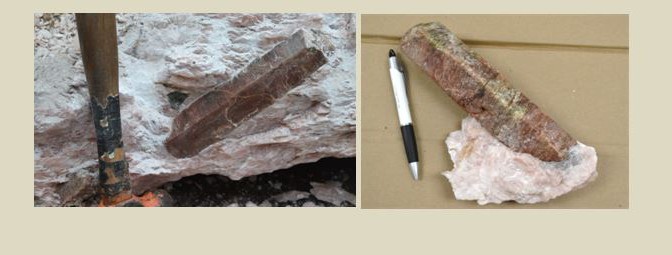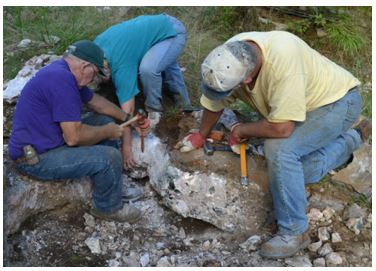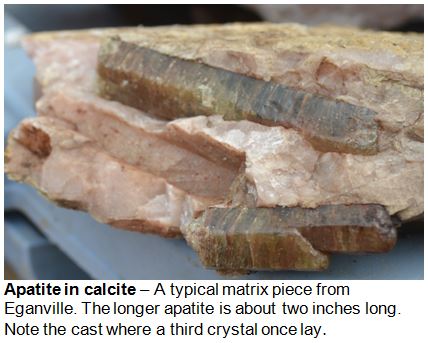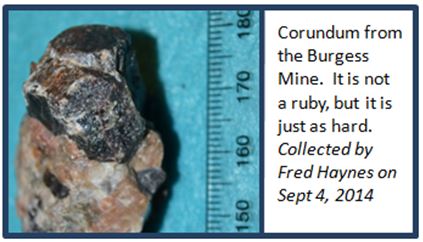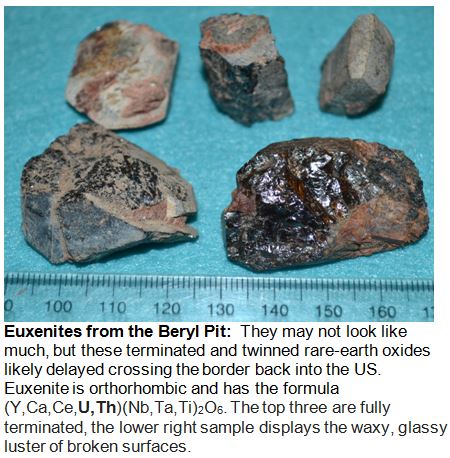Article I wrote for WCGMC News in Oct., 2014
Four of us (Linda Schmidtgall, Bill Chapman, Ken St. John, Fred Haynes) decided one summer trip to eastern Ontario was simply not enough and we returned for 4 days in early September. The highlight was a return to the Miller Property in Eganville, but we managed to squeeze three other sites into the trip, including a pair of lesser known sites in the Bancroft Chamber of Commerce 2013 collecting book.
We started with a visit to the well known Beryl Pit in Quadeville. Fred had visited with the Rochester Club in July and since that time the owners (Dave and Renee Paterson) had excavated a significant amount of material in the floor of the pegmatite quarry and piled it outside the quarry. This made for easy pickings for beryl, quartz, tourmaline (var. schorl), cleavlandite, albite, perthite, fluorite, and euxenite. We later learned that we may have taken more than our limit on that last one. Keep reading to learn why!
On day two we headed to Eganville and brought out the rock saw and went to work on the calcite veins in the main trench area. The apatites here are large, note the field and home pictures of an 8″ red apatite in the cover photo above. We loaded up on pink calcite, with and without apatite, and trekked into the woods for large biotite books with red apatite matrix and for amazonite. The microcline crystals are not particularly flashy, but they are also very collectible, either in float or when they can be removed from the hard vein walls.
Teamwork is yielding titanite and apatite at the Miller Property in Eganville.
As all who collect in Canada know, the US customs folks frown on bringing dirt back into the US. Sometimes rocks are dirty, or can appear so to a cursory viewing at the border. So we take care to wash our treasures whenever we can.
With our field vehicle loaded, we decided to try out two of the lesser known sites in the Bancroft area to complete the trip. None of us had been to either the Burgess Mine in Cardiff Township or the Saranac Mine in Monmouth Township.
The former consists of a syenite gneiss cut by a leuco syenite pegmatite. The syenite is highly silica deficient permitting corundum (Al2O3) to occur as a primary rock forming mineral. The coarse corundum crystals are gray with nice luster, but are not of gem quality. Too bad, gem corundum is ruby! The Burgess Corundum Mine operated from 1902-1917. We did not find too many free standing corundum crystals, but each of us did leave with several terminated crystals.
Our final stop was a dump, literally. We circumvented the Monmouth dump on foot, dodging bear scat and garbage that bears had dragged into the woods, to find the Saranac Mine. Zircons and other radioactive minerals occur within a thin granite pegmatite intruding marble. So do mosquitoes! The zircons are said to reach 2 cm in length. They have either shrunk since the Bancroft CC report of 2013 or we were not looking in the proper dump! We found lots of zircons, both as well formed crystals standing off the rock and loose in the fine gravel on the dump, but most were 1 cm or smaller. Or about the same size as the mosquitoes that helped us collect.
The final step of the trip was to successfully pass through customs with our carefully cleaned and organized treasures. Unfortunately, the lights all turned red as we passed into the Thousand Islands customs booth and two officials descended on our vehicle. We learned that we had tripped their radioactive detection equipment. It could have been just about anything we collected, but it is my bet that the 1”-2” euxenites from the Beryl Pit were the culprit. They had us pull to the side. Twenty minutes later after they had checked out our vehicle we were allowed to return, and keep our treasures as well.
